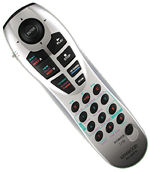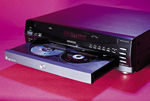HT Boot Camp: The Ultimate DVD Boot Camp Page 2

Every player offers the ability to downconvert the anamorphic widescreen image to look normal on a 4:3-shaped TV, but you'll lose the increased resolution and gain some motion artifacts in the process. Some players smooth out the motion artifacts and soften the picture ever so slightly. Other players preserve the image's detail while making the artifacts glaringly obvious. Play chapter 8 from the James Bond film Tomorrow Never Dies in the 4:3 letterboxed mode, and watch the building's door and window frames to see how a particular player performs. Of course, if you have a widescreen TV or a 4:3 TV with a widescreen mode, you'll avoid the downconversion altogether and preserve the image's maximum resolution.
DTS: Digital Theater Systems (DTS) has a 5.1-channel system that competes with Dolby's, both theatrically and at home. It has the same number of channels, but it's a completely incompatible system. At this point, almost all players output the DTS signal (first-generation players didn't) in addition to the Dolby Digital signal, so you might as well look for it. Keep in mind, though, that you'll need DTS-encoded software and DTS processing in your receiver for it to be of any use.
Dual video outputs: Another convenient feature is the ability to send the composite or S-video signal to two places at once. (It's rare to find a player with dual component outputs.) While most systems won't need this, it's far more useful than, say, 5.1 analog outputs.
 DVD-Audio: The newest addition to the DVD format's list of features is the ability to use the disc's massive storage capacity to record 5.1 channels of high-resolution audio (see Chris Lewis' feature on DVD-Audio in this issue). If you like to sit in a darkened room and listen to music for hours, by all means take the plunge and look for a player that can read DVD-Audio software. As usual, you'll need a receiver or preamp with a 5.1-channel analog input (which usually uses a DB-25 connector that looks like the printer port on your computer) and, well, software, which is currently in limited supply. Some pieces of DVD-Audio software—those that also include a Dolby Digital soundtrack—can be played on regular DVD players. If you listen to music as background noise, you might want to wait a year or two, when this feature will likely be found on nearly every player.
DVD-Audio: The newest addition to the DVD format's list of features is the ability to use the disc's massive storage capacity to record 5.1 channels of high-resolution audio (see Chris Lewis' feature on DVD-Audio in this issue). If you like to sit in a darkened room and listen to music for hours, by all means take the plunge and look for a player that can read DVD-Audio software. As usual, you'll need a receiver or preamp with a 5.1-channel analog input (which usually uses a DB-25 connector that looks like the printer port on your computer) and, well, software, which is currently in limited supply. Some pieces of DVD-Audio software—those that also include a Dolby Digital soundtrack—can be played on regular DVD players. If you listen to music as background noise, you might want to wait a year or two, when this feature will likely be found on nearly every player.
Enhanced IRE black level: Our NTSC system's luminance (black-and-white) signal goes from 7.5 IRE to 100 IRE. This is referred to as "setup." Japan's NTSC system goes from 0 to 100 IRE and does not have setup. DVDs are recorded with a 0- to a 100-IRE signal. All U.S. players step up the signal to 7.5 to 100 IRE so that it will be compatible with other sources. Otherwise, when you switch from DVD to regular TV, the black level would change rather dramatically. Some players with "enhanced" black levels offer the ability to preserve the 0- to 100-IRE output, assuming that your TV's DVD input has a separate black-level control or that you're willing to change the black level every time you switch sources. This would offer an image with slightly better gradations between light and dark, but it's not worth the hassle for most people.
 Ergonomics: Of all the features in a DVD player, one of the most important is its ergonomics or ease of use. I don't know if this says more about other features' lack of importance or about how difficult DVD players are to use, but it's rare that you can just put a disc in the tray and press play. A quick survey of the office indicated some common pet peeves. For one, some players are slow to turn on and boot up. This disables many functions, like the disc-eject button, until the player is ready. Others disliked players with cryptic remotes, arguing that they might as well come with a Super-Spy decoder ring. Nobody really needed a jog/shuttle wheel to access each video frame one by one, but we thought we'd mention it nonetheless. What about the screen-saver functions? Pause most players for too long, and the player will kick into screen-saver mode in an attempt to prevent the paused image from burning into your TV screen. Does the player retain the pause but mute the video output? Does it stop the disc entirely? Will it put an ugly dancing logo on the screen? Your best bet is to play with the unit at the store and get a feel for how it works before you buy it.
Ergonomics: Of all the features in a DVD player, one of the most important is its ergonomics or ease of use. I don't know if this says more about other features' lack of importance or about how difficult DVD players are to use, but it's rare that you can just put a disc in the tray and press play. A quick survey of the office indicated some common pet peeves. For one, some players are slow to turn on and boot up. This disables many functions, like the disc-eject button, until the player is ready. Others disliked players with cryptic remotes, arguing that they might as well come with a Super-Spy decoder ring. Nobody really needed a jog/shuttle wheel to access each video frame one by one, but we thought we'd mention it nonetheless. What about the screen-saver functions? Pause most players for too long, and the player will kick into screen-saver mode in an attempt to prevent the paused image from burning into your TV screen. Does the player retain the pause but mute the video output? Does it stop the disc entirely? Will it put an ugly dancing logo on the screen? Your best bet is to play with the unit at the store and get a feel for how it works before you buy it.
 Multidisc changers: The idea of loading all five Planet of the Apes movies into a DVD player for a day-long marathon of apocalyptic movie watching may not be your brand of excitement. The real fun with a DVD changer is the ability to use it as a CD changer. There doesn't seem to be a noticeable qualitative difference between changers and single-disc players. So, if you want one player to do it all, get a changer.
Multidisc changers: The idea of loading all five Planet of the Apes movies into a DVD player for a day-long marathon of apocalyptic movie watching may not be your brand of excitement. The real fun with a DVD changer is the ability to use it as a CD changer. There doesn't seem to be a noticeable qualitative difference between changers and single-disc players. So, if you want one player to do it all, get a changer.
MP3: This is yet another audio-encoding format that allows millions of teens to download their favorite pop songs off the Internet, teaching them valuable lessons about copyright law. The anti-thesis of DVD-Audio, MP3 allows you to record nearly 10 hours of two-channel music with acceptable sound quality. A few DVD players now offer the ability to play MP3s that are recorded onto a CD-R. If you don't need DVD-Audio, you might consider this option.
- Log in or register to post comments





























































